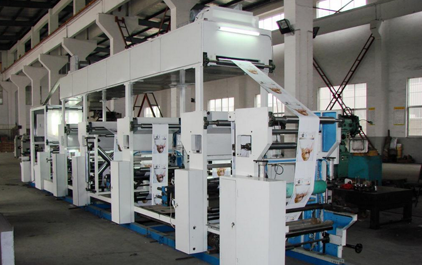
For more information about Nuo Xin Machinery, please see here!
| Cascade flexographic printing press basics |
| Release date:2017/5/27 10:53:00 Hits:1506 News source: |
 |
| The structure of the stacked flexographic printing press (see Fig. 1) is a method in which a plurality of independent printing layers are assembled on one or both sides of the frame in layers in the upper and lower layers. Each printing group is driven by a gear train mounted on the main wall panel. Cascade presses can contain 1 to 8 printing color groups, but people are common flexographic printing presses are composed of six color groups. Cascade flexographic printing press has three major advantages. First, the operator in a process of paper through the flip paper to achieve double-sided printing. Through a variety of different transfer routes, if sufficient drying time is designed between the successive printing units of the tape, the full drying of the front ink can be achieved before the reverse printing is carried out. Second, the printing group has a good accessibility, making the replacement of printing and cleaning operations more convenient. Third, you can print large format prints. Cascade flexographic printing press for a wide range of applications, almost all kinds of printing materials. But in some occasions also have some limitations. When the substrate is a ductile material or a very thin material, the overlay flexographic printing press's overprint accuracy is difficult to achieve the requirements of ± 0.8mm, so that when the color prints have its limitations. However, when the substrate is a thicker material, such as paper, multi-layer composite film or other materials can withstand a very high material tension, the stack of flexographic printing presses easier to print out both economic and good Of commercial prints. |
| prev:Printing machinery industry fo... |
|---|
Copyright Ruian NuoXin Machinery Co., LTD All Rights Reserved. Address:Building A, No.3588. Dongshan Development Zone Avenue, Ruian city, wenzhou, Zhejiang, China